Leveraging HTTP缓存
不只是服务端的缓存,你通过设置HTTP头可以使用客户端缓存。
在这个小节中,我们将会讨论基于Last-Modified和ETag头的全页缓存。
准备
按照官方指南http://www.yiiframework.com/doc-2.0/guide-start-installation.html的描述,使用Composer包管理器创建一个新的yii2-app-basic应用。
- 创建并运行migration:
<?php
use yii\db\Migration;
class m160308_093233_create_example_tables extends Migration
{
public function up()
{
$this->createTable('{{%article}}', [
'id' => $this->primaryKey(),
'created_at' => $this->integer()->unsigned()->notNull(),
'updated_at' =>
$this->integer()->unsigned()->notNull(),
'title' => $this->string()->notNull(),
'text' => $this->text()->notNull(),
]);
}
public function down()
{
$this->dropTable('{{%article}}');
}
}
- 创建
Article模型:
<?php
namespace app\models;
use Yii;
use yii\behaviors\TimestampBehavior;
use yii\db\ActiveRecord;
class Article extends ActiveRecord
{
public static function tableName()
{
return '{{%article}}';
}
public function behaviors()
{
return [
TimestampBehavior::className(),
];
}
}
- 创建带有如下动作的博客控制器:
<?php
namespace app\controllers;
use app\models\Article;
use yii\web\Controller;
use yii\web\NotFoundHttpException;
class BlogController extends Controller
{
public function actionIndex()
{
$articles = Article::find()->orderBy(['id' =>
SORT_DESC])->all();
return $this->render('index', array(
'articles' => $articles,
));
}
public function actionView($id)
{
$article = $this->findModel($id);
return $this->render('view', array(
'article' => $article,
));
}
public function actionCreate()
{
$n = rand(0, 1000);
$article = new Article();
$article->title = 'Title #' . $n;
$article->text = 'Text #' . $n;
$article->save();
echo 'OK';
}
public function actionUpdate($id)
{
$article = $this->findModel($id);
$n = rand(0, 1000);
$article->title = 'Title #' . $n;
$article->text = 'Text #' . $n;
$article->save();
echo 'OK';
}
private function findModel($id)
{
if (($model = Article::findOne($id)) !== null) {
return $model;
} else {
throw new NotFoundHttpException('The requested page does not exist.');
}
}
}
- 添加
views/blog/index.php视图:
<?php
use yii\helpers\Html;
$this->title = 'Articles';;
$this->params['breadcrumbs'][] = $this->title;
?>
<?php foreach($articles as $article): ?>
<h3><?= Html::a(Html::encode($article->title), ['view',
'id' => $article->id]) ?></h3>
<div>Created <?= Yii::$app->formatter->asDatetime($article->created_at) ?></div>
<div>Updated <?= Yii::$app->formatter->asDatetime($article->updated_at) ?></div>
<?php endforeach ?>
- 添加视图
views/blog/view.php:
<?php
use yii\helpers\Html;
$this->title = $article->title;
$this->params['breadcrumbs'][] = ['label' => 'Articles', 'url' => ['index']];
$this->params['breadcrumbs'][] = $this->title;
?>
<h1><?= Html::encode($article->title) ?></h1>
<div>Created <?= Yii::$app->formatter->asDatetime($article->created_at) ?></div>
<div>Updated <?= Yii::$app->formatter->asDatetime($article->updated_at) ?></div>
<hr />
<p><?= Yii::$app->formatter->asNtext($article->text) ?></p>
如何做...
执行如下步骤来leverage HTTP缓存:
- 访问
http://yii-book.app/index.php?r=blog/create三次,来创建三个文章。 - 打开如下博客地址:
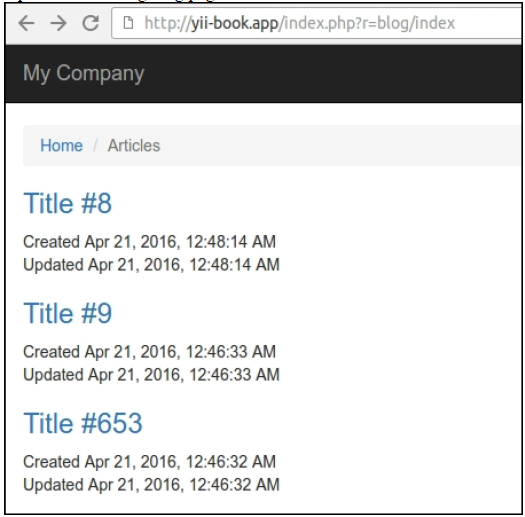
- 在你的浏览器中打开开发者控制台,每次刷新页面都可以看到
200 OK的响应状态:

- 打开
BlogController并附加如下行为:
<?php
class BlogController extends Controller
{
public function behaviors()
{
return [
[
'class' => 'yii\filters\HttpCache',
'only' => ['index'],
'lastModified' => function ($action, $params) {
return Article::find()->max('updated_at');
},
],
[
'class' => 'yii\filters\HttpCache',
'only' => ['view'],
'etagSeed' => function ($action, $params) {
$article = $this->findModel(\Yii::$app->request->get('id'));
return serialize([$article->title, $article->text]);
},
],
];
}
// ...
}
- 接下来,刷新页面几次,并检查服务器返回的是
304 Not Modified,而不是200 OK:
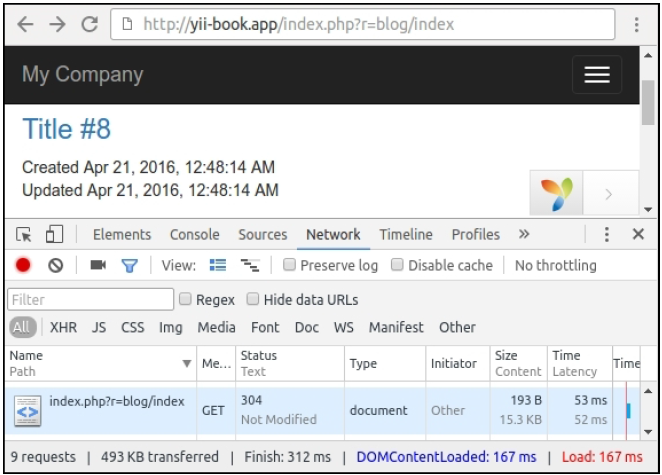
- 使用如下URL打开相关页面,更新相关文章:
http://yiibook.app/index.php?r=blog/update。 - 更新过博客页面以后,检查服务器首次返回的是
200 OK,接着就是304 Not Modified,并确认你在页面上看到了新的更新时间:
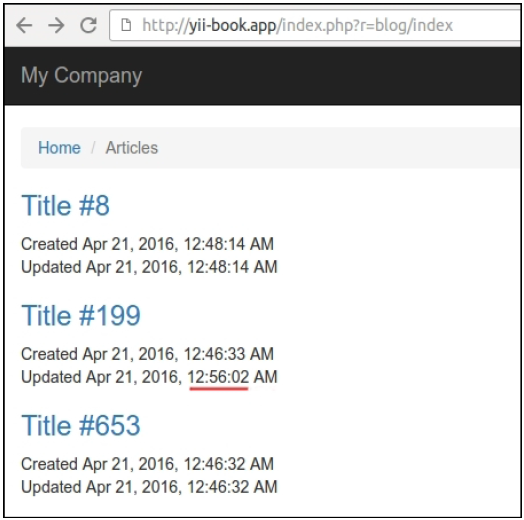
- 从我们的页面上打开任何页面:

确认服务器首次返回的是200 OK,以及接下来的请求是304 Not Modified。
工作原理...
在HTTP头的帮助下,你的浏览器用基于时间和基于内容的方法,来检查缓存响应内容的可用性。
上次修改时间
这个方法建议服务端必须返回每个文章的上次修改时间。在存储这个这个日期之后,我们的浏览器可以在接下来的每次请求中,在If-Modified-Since头设置这个值。
我们必须附加这个action过滤器到我们的控制器中,并指定lastModified回到:
<?php
class BlogController extends Controller
{
public function behaviors()
{
return [
[
'class' => 'yii\filters\HttpCache',
'only' => ['index'],
'lastModified' => function ($action, $params) {
return Article::find()->max('updated_at');
},
],
// ...
];
}
// ...
}
\yii\filters\HttpCache类调用这个回调,并将返回值和$_SERVER['HTTP_IF_MODIFIED_SINCE']系统变量进行比较。如果这个文章没有改变,HttpCache将会发送一个轻量级的304响应头,而且不需要运行这个动作。
但是,如果文档更新了,这个缓存将会失效,服务端将会返回一个完整的响应。
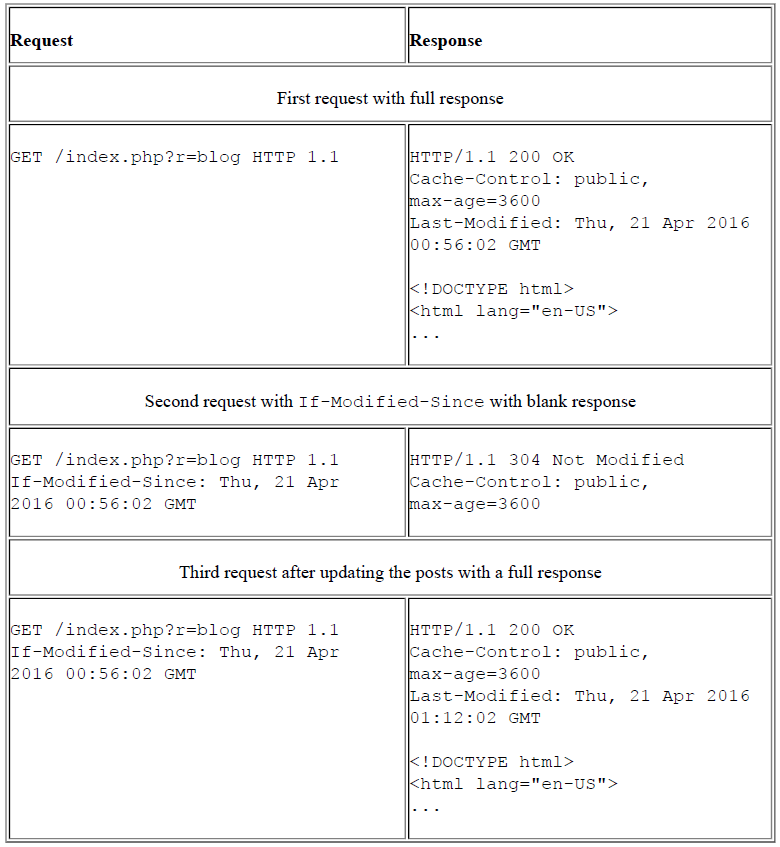
作为Last-Modified的备选或者补充,你可以使用ETag。
Entity标签
如果我们没有存储上次修改时间,我们可以使用自定义hash,它可以基于文章的内容生成。
例如,我们可以为我们的文档使用一个内容标题,来做了一个hash值:
class BlogController extends Controller
{
public function behaviors()
{
return [
[
'class' => 'yii\filters\HttpCache',
'only' => ['view'],
'etagSeed' => function ($action, $params) {
$article =
$this->findModel(\Yii::$app->request->get('id'));
return serialize([$article->title,
$article->text]);
},
],
];
}
// ...
}
这个HttpCache过滤器会将这个tag附加到服务器响应的ETag头变量上。
在存储了ETag之后,我们的浏览器会为接下来的每次请求附加它在If-None-Match头上。
如果这个文档仍然为改变,HttpCache将会发送一个轻量级的304响应头,并且不需要运行这个动作。
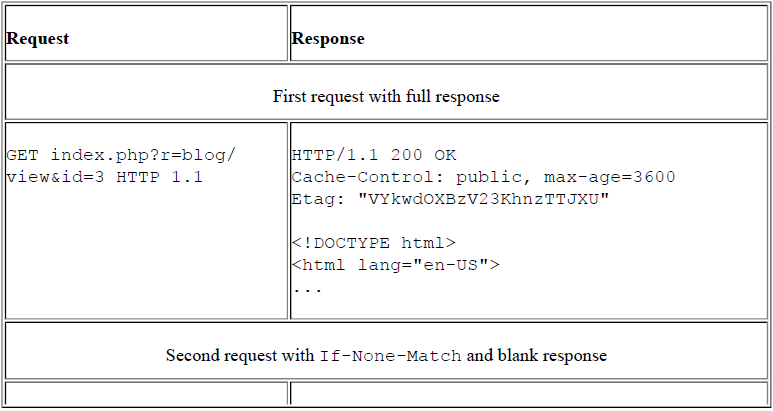
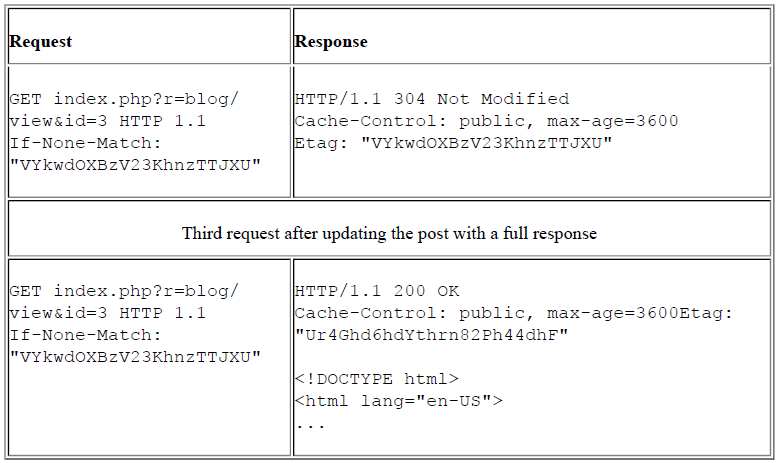
当这个缓存是合法的,我们的应用将会发送304 Not Modified响应头,而不是页面内容,而且不会重复运行控制器和动作。